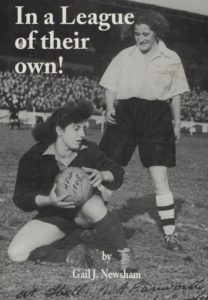England in the 2023 Women’s Football World Cup
It’s that time again, when we can hope and dare to dream: that England CAN win the 2023 World Cup in New Zealand and Australia. They have a good chance. It’s a great time for women’s football…and it’s a good time to look back at its history.
 As we all know, women’s football grew massively in World War One. The Dick Kerr Munitions Works encouraged their women workers to play football during World War One to improve their health and morale. After they beat their male factory co-workers in an informal lunchtime match, the women’s team decided to take their football a little more seriously. They played their first public match in 1917 in front of 10,000 spectators. They beat Arundel Coulthard Factory 4-0. By 1920, they were playing St Helen’s Ladies at Goodison Park in front of 53,000 spectators with 14,000 more trying to get into the grounds.
As we all know, women’s football grew massively in World War One. The Dick Kerr Munitions Works encouraged their women workers to play football during World War One to improve their health and morale. After they beat their male factory co-workers in an informal lunchtime match, the women’s team decided to take their football a little more seriously. They played their first public match in 1917 in front of 10,000 spectators. They beat Arundel Coulthard Factory 4-0. By 1920, they were playing St Helen’s Ladies at Goodison Park in front of 53,000 spectators with 14,000 more trying to get into the grounds.
In 1921 the FA banned women’s football from FA grounds. The men had returned from the War and demand for pitches was too great. All of a sudden football was deemed an unsuitable game for women’s health. The ban lasted 50 years. Undeterred, Dick Kerr Munitions Works Women’s team renamed themselves Preston Ladies FC and carried on playing. In 1926 they played the Edinburgh Ladies and won 5-1. Deemed an international match, in fact THE international match, Preston Ladies therefore became unofficial World Champions. It would be great if England could make it official this time around.
England’s Lionesses in the Women’s Euros 2022: How far women’s football has come!
How proud would these pioneers of women’s football from 1918 be to see England’s Lionesses perform in the Women’s Euros 2022?!
 When this Scottish women’s team played in 2018, they would have rightly believed they had already come far. Despite attempts to set up and build up women’s football in the nineteenth century, it was World War One that gave women’s footballers the push they needed. Up until then, too many people still believed that football was still very much a man’s game and women playing it was viewed as unseemly.
When this Scottish women’s team played in 2018, they would have rightly believed they had already come far. Despite attempts to set up and build up women’s football in the nineteenth century, it was World War One that gave women’s footballers the push they needed. Up until then, too many people still believed that football was still very much a man’s game and women playing it was viewed as unseemly.
In World War One, however, many women worked together in factories for the first time. They were encouraged to keep fit for work. So they banded together to form football teams and fill the football stadiums that the men had left behind them as they went off to fight. By 1920 a Boxing Day football match between England’s top female teams, Dick, Kerr Ladies v St Helen’s, filled Everton’s Goodison Park stadium with 10,000 turned away at the gates.
But women’s football became a victim of its own success. Feeling threatened, possibly, by the success of women’s football and what effect that might have on men’s football after World War One, the FA issued a ban on 5th December 2021. No member club could let women’s teams play on their grounds. They claimed that women’s teams had siphoned off money they raised for charity for their expenses. They encouraged some doctors’ views that playing football might be bad for a woman’s body and might even stop a woman becoming pregnant.
The FA stuck to its edict. In 1947 the Kent County FA suspended a referee because he also trained a women’s football team. It was only in 1971 that the FA finally lifted their ban against women’s football. How we’d love to go back and tell all those women footballers, who persevered despite all obstacles, that in 2022 the BBC delayed the News at 10 so that we could all watch the end to another thrilling Lionesses’ game (depending on how far back we went, we might have a struggle explaining the BBC’s News at 10 first!).


 When this Scottish women’s team played in 2018, they would have rightly believed they had already come far. Despite attempts to set up and build up women’s football in the nineteenth century, it was World War One that gave women’s footballers the push they needed. Up until then, too many people still believed that football was still very much a man’s game and women playing it was viewed as unseemly.
When this Scottish women’s team played in 2018, they would have rightly believed they had already come far. Despite attempts to set up and build up women’s football in the nineteenth century, it was World War One that gave women’s footballers the push they needed. Up until then, too many people still believed that football was still very much a man’s game and women playing it was viewed as unseemly.